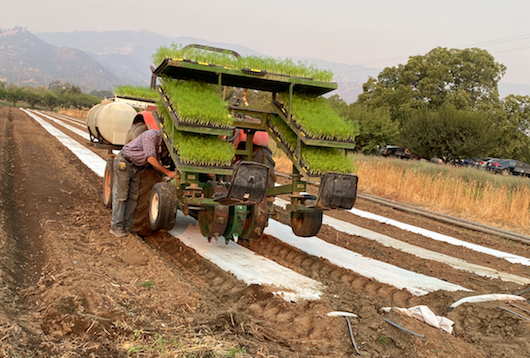
We’ve reached that time of the summer: Almost everything and everyone is pretty hot, tired, dusty, and ready for the end of summer, but we aren’t there yet. September is a very busy month that bridges summer and fall. We continue summer harvesting activities and get prepared for the cooler months by clearing old fields and planting new crops. Members of our summer crew who are students have headed back to the classroom, so our workforce has shrunk while the workload still is high. We had a bit of a reprieve from the heat and smoke last week, with blue skies and maximum temperatures in the upper 80s, and days are getting shorter and nights a little cooler, but it’s just a tease of what’s to come; we’re back in the 100s this week and have more summer ahead.

To prepare for those cooler days, when crops are done, the sheep often graze down the plant residue, then we remove the drip tape, and then the tractor team prepares the soil for the next crop. Transplanting teams have already put kale, chard, fennel, broccoli, potatoes, and more into the ground. Turnips, carrots, and beets have been direct seeded. The greens on the potatoes have just started poking up from the soil, the turnips have germinated, and the carrots are just about there. All of these new crops need water as soon as they’re transplanted, so we have to lay out drip tape or move sprinkler pipes around, keeping the irrigators busy. The water brings up lots of weeds, in addition to the new plants, so plenty of weeding is just around the corner, by hand (or hoe), by tractor, or by flame weeder.

Potato plants peeking through the soil.
We’ve started cutting winter squash! Despite the name, they grow during the summer, and when they’re ready, we cut off the water and let the plants dry down. Then we cut the squash from the plants and let them cure in the field for a few days to help preserve them. Then we’ll collect them and put them into big bins for storage and then draw from our supply.
All but one variety of almonds has been harvested, hulled, and shelled and are back at the farm to be hand sorted (below) to remove damaged nuts. Soon enough we’ll have a new batch of almond butter! Walnut harvest hasn’t happened yet, that’s next month.

We are still harvesting loads of melons and eggplants, plenty of peppers, and lots of flowers. The melons are going to taper off soon but eggplants show no indication of slowing down. We’re leaving eggplants out of the CSA boxes this week, but they’ll be back.
One thing we’d normally be doing is harvesting, sorting, and packing tomatoes. But not this year. Instead, we’re already taking out the last of our three plantings, much earlier than we normally would. This has been a horrible year for our tomatoes, and for many of our neighbors and other peer farmers in the area.
What happened? First, our tomatoes were hit with curly top virus. It’s spread between plants by the beet leafhopper and plants with this virus are small and stunted, then leaves turn yellow or bronze and brittle, then the plants die. Or they might survive but produce dull, small fruits. The tomatoes that didn’t succumb to this virus, or weren’t infected, were impacted by Fusarium, a fungus that first wilts and then kills the plants. There are three different “races” of Fusarium and various tomato varieties are resistant to one or more races, either naturally or as a result of plant breeding, but not every variety is resistant and there is nothing we can do to save an infected plant within that season, aside from cleaning our equipment to avoid spreading it between fields. Going forward, we shouldn’t plan to use the field for tomatoes for a few years, but that’s our normal crop rotation practice anyways.
The end result of these two factors was a supremely small and disappointing tomato crop, which is usually our biggest source of revenue. But just as it’s no use crying over spilt milk, there’s no use dwelling too much on the tomato crop that wasn’t, especially when there’s so much other work to do. We’ve got more of each of the described tasks above to do this week and more. So on this Labor Day when we’re hard at work, lots of appreciation for our all the folks that make up Full Belly Farm who get all these things done.
— Elaine Swiedler, CSA Manager
